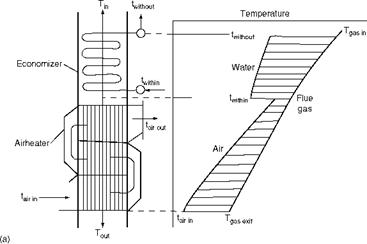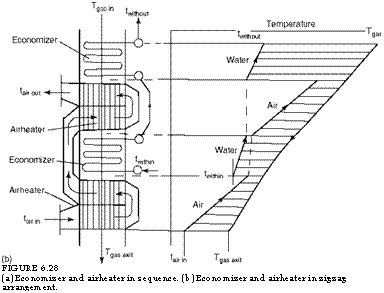Economizer and airheater are called the back-end equipment. They are the last of the heat traps and positioned behind the evaporator surfaces in bidrum boilers and behind SH/RH surface in radiant boilers. The ECON is so-called because it economizes the fuel usage by extracting the low-grade heat. Flue gases leave the evaporator in bidrum boilers and the SH in single-drum boilers at a maximum temperature of —500 and 600°C, respectively and are cooled to an optimal level at the back end.
• The design of the back end requires great care and skill, as the boiler efficiency increases by —1% point for every 22°C (40°F) of drop in exit temperature. In an effort to recover the low-grade heat, excessive surfacing may increase the costs. Balancing is most important.
• The optimum level for cooling the gases is dependent on the fuel and its cost and can vary from as low as 75°C (~165°F) in HRSGs firing natural gas to ~160°C (320°F) or even higher for high-sulfur fuels. For most common fuels, such as coal and oil with low sulfur, the gas exit temperature is ~140°C (285°F) at full load; the limit is imposed by the corrosion of the downstream flues and dust-collecting equipment at part load operation.
• Although ECON and AH are both for recovery of heat at the final levels, there is an important difference in the way the heat is returned to the system. In ECON, the heat from the flue gas is transferred directly to ECON water, whereas in AH, the transfer is indirect. Heat is transferred to the cold combustion air that enters into the furnace as hot air, raising the furnace temperature and then giving away the heat to the furnace and the SH. Thus FEGT is always higher with a unit equipped with AH, and slagging and fouling aspects have to be checked. Combustion speed is also enhanced. Even though both are back-end heat traps, the AH and ECON must be evaluated on a case-to-case basis.
The back end may consist of only ECON or a combination of ECON and AH, depending on the fuel and process. The inclusion of AH is compulsory where the combustion process demands hot air, such as in PF, biofuels, and BL. In power plant boilers, where the FW temperatures are high, the ECON alone cannot cool the gases. In HRSGs, however, the AHs are conspicuous by their absence. In these days of low gas exit temperatures, AH alone as back-end equipment is a rarity because the hot air temperature so obtained would not be acceptable to most firing equipment and flues. If the flue gases are not cooled adequately, the hot exhaust gases would be too hot for fans, dust collectors, and stack.
Besides reducing the gas temperature, the ECON performs another important task of narrowing the difference between feed and drum temperatures, thereby reducing the thermal shock to drum and water walls.
This requires understanding of process side of water and air.
• In most process plants, condensate returns at 40-90°C to the deaerator from where, after deaeration and chemical addition, the FW enters the boiler at 105°C. In such cases no AH is required if hot air is not needed for combustion.
• If hot air is needed, an AH of appropriate size is provided behind the ECON, so that together they provide hot air and cold flue gas as required for the system.
• In power plants, regenerative heating delivers the FW at temperatures of 160-270°C, necessitating both AH and ECON.
• In combined cycle pressure parts (CCPPs), the condensate at ~40°C returns to the HRSG from the condenser because there are no heaters in the cycle. A condensate preheater is the last heat trap in the HRSG located behind the ECON. The exit gas temperature can be as low as 75°C, depending on the sulfur in the fuel.
As the AH and ECON extract low-grade heat, they experience low thermal heads to drive the heat and hence are very large HXs. The ECON has nearly three to four times greater heat-transfer coefficient than the AH, which is a gas-air HX. Economizer heat transfer is governed by gas-side coefficient only, whereas the AH coefficient is governed by both gas
and air sides, nearly in equal measure. This is the reason for the large difference in heat — transfer rates of the two systems. Airheater surface is, therefore, three to four times that of an equivalent ECON.
An economizer is a PP and hence expensive but more compact. On the contrary, since an AH is three to four times as large and more voluminous, it is often more expensive to build, although it is a nonpressure part (NPP). In an AH, the ducting adds to the cost significantly and its routing affects the layout tremendously.
Airheater and Economizer Arrangements

|
FIGURE 6.28 (a) Economizer and airheater in sequence. (b) Economizer and airheater in zigzag arrangement. |
 Economizer and airheater can be arranged along the gas flow either in sequence or in zigzag fashion as shown in Figure 6.28a and b. The reason for zigzag arrangement is to get high air temperatures with less HS. In an AH, the rise in air temperature is faster than the drop in gas temperature due to the higher weights and specific heats of gas. Typically for
Economizer and airheater can be arranged along the gas flow either in sequence or in zigzag fashion as shown in Figure 6.28a and b. The reason for zigzag arrangement is to get high air temperatures with less HS. In an AH, the rise in air temperature is faster than the drop in gas temperature due to the higher weights and specific heats of gas. Typically for
Low-moisture fuels such as coal and oil, the air temperature increases by ~1.2°C for every 1°C drop in gas temperature, whereas for high-moisture fuels such as bagasse, it is as high as 1.6°C.



 26 августа, 2013
26 августа, 2013  admin
admin  Опубликовано в рубрике
Опубликовано в рубрике